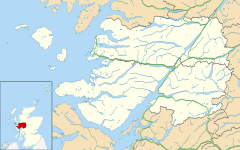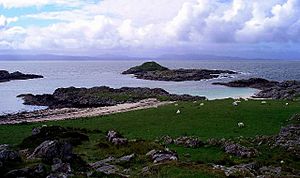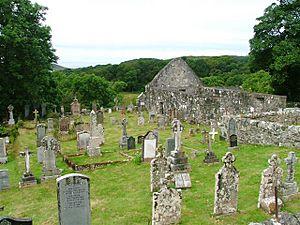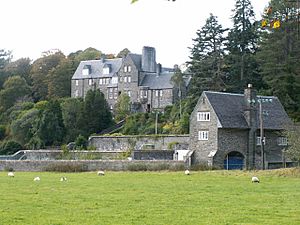Arisaig facts for kids
Quick facts for kids Arisaig
|
|
|---|---|
| Population | 300 |
| OS grid reference | NM661865 |
| Council area | |
| Country | Scotland |
| Sovereign state | United Kingdom |
| Post town | ARISAIG |
| Postcode district | PH39 |
| Dialling code | 01687 |
| Police | Northern |
| Fire | Highlands and Islands |
| Ambulance | Scottish |
| EU Parliament | Scotland |
| UK Parliament |
|
| Scottish Parliament | |
Arisaig (pronounced "ARR-iss-ayg") is a small village in Lochaber, Scotland. Its name means "safe bay." It's located about 7 kilometers (4 miles) south of Mallaig on the west coast of the Scottish Highlands. Arisaig is also the traditional name for the area around the village. About 300 people live here.
Contents
Ancient Times in Arisaig
Archaeologists have found many interesting things in Arisaig. These discoveries help us understand how people lived here long ago.
Stone Age Discoveries
When a main road (the A830) was being improved, experts found signs of very old human activity. They found a special type of stone circle called a "kerb cairn" from the Bronze Age. This was around 4,500 years ago! They also found remains of turf buildings and small huts. These huts were used by people who moved their animals to different pastures in summer. These huts were used again and again over hundreds of years.
Scientists also studied old peat from the area. They learned that forests slowly became smaller over thousands of years. This started around 3200 BC. The studies also showed that people have lived in Arisaig constantly since about 2500 BC. But there were not many people living here. Around 500 BC, more animals were grazing in the area. This suggests more people were living and farming there.
Mysterious Burnt Mounds
More road work in 2005 led to another exciting find. Archaeologists found a "burnt mound." This was the first one ever found in this part of the Highlands. A burnt mound is a pile of stones that have been heated up, often with water. This one was from the early Bronze Age, between 2550 and 1900 BC.
No one is completely sure what burnt mounds were used for. Some ideas are that they were for cooking, or maybe even for saunas or making drinks. Sadly, the Arisaig burnt mound didn't solve this mystery!
Arisaig's Rich History
Arisaig has a long and exciting history, with many changes in who ruled the land.
Early Rulers and Vikings
Around the 700s AD, Vikings often raided the Scottish coasts. Arisaig became part of the Kingdom of the Isles, which was controlled by Norway. But in the late 1000s, the Scottish King Malcolm III made a deal with the Norwegian King. The border moved to the coast, and Arisaig became part of Scotland.
In the early 1100s, a powerful leader named Somerled took control of Arisaig and the surrounding area. He created a large kingdom. After Somerled died, Norway took control again, but his lands were split. The part that included Arisaig was called Garmoran. It was ruled by the MacRory family, who were Somerled's descendants.
Becoming Scottish Land
In 1266, the Treaty of Perth made Garmoran officially part of Scotland. It was still ruled by the MacRory family. The last MacRory heir was a woman named Amy of Garmoran. She married John of Islay, who was the leader of the powerful MacDonald clan. He ruled most of the other islands.
John and Amy had three sons. But later, John divorced Amy to marry the king's niece. As part of this deal, he gave Arisaig and Garmoran to his eldest son with Amy, named Ranald. This made Ranald the Lord of Garmoran.
However, Ranald's sons were too young when he died. His younger brother, Godfrey, took control instead. This led to many fights between Godfrey's family and Ranald's family. The records don't tell us all the details, but it was a very violent time.
By 1427, King James I of Scotland was tired of all the fighting in the Highlands. He called all the powerful leaders to a meeting. Many were arrested. Alexander MacGorrie, Godfrey's son, was executed. The King then took control of Garmoran himself.
New Owners of Arisaig
In 1469, King James's grandson, James III, gave the lands of Garmoran to John of Ross, who was the Lord of the Isles. John then gave it to his half-brother, Hugh of Sleat. The King confirmed this in 1493.
But Ranald's descendants, the Clan Macdonald of Clanranald, fought against this. When Hugh of Sleat died, his son gave the land back to the King. Around this time, John of Ross lost his own lands too.
In 1501, John of Ross's heir, Donald Dubh, started a rebellion to get the Lordship of the Isles back. Ranald Bane, the leader of Clan Ranald, was one of the few who didn't support Donald. So, as a reward, the King gave Ranald Bane the lands of Arisaig and Eigg in 1505.
Later, in 1520, Ranald Bane's son, Dougall, was killed because he was too cruel. His family lost the leadership of Clan Ranald. Ranald Bane's brother, Alexander, became the new leader. In 1532, the King confirmed that Alexander's son, John Moidartach, was the official owner of Arisaig and Eigg.
Later Years and Important Events
In 1700, a Catholic Bishop named Thomas Nicolson visited Arisaig. He was welcomed by the Clanranald Chief. The Bishop wrote about the old tombs he saw near a chapel in Arisaig. These tombs had amazing carvings of priests, weapons, and animals. He said they showed how skilled the people were at carving.
A very famous event happened in Arisaig in 1746. Bonnie Prince Charlie left Scotland from a spot near the village. This was after his attempt to become king failed. A monument called the Prince's Cairn marks the place where he left.
Arisaig is also important for Scottish Gaelic literature. Alasdair Mac Mhaighstir Alasdair, a famous Scottish Gaelic poet and teacher to Bonnie Prince Charlie, died in Arisaig in 1770. He was buried in the cemetery there. A plaque was put up in 1927 to honor him as a great Gaelic poet.
During the Highland Clearances, many people from Arisaig moved to Canada. In 1785, they founded a new town there called Arisaig, Nova Scotia.
In the 1820s, the Clanranald Chief, Ranald George, sold almost all of the old Clan lands, including Arisaig.
During the Highland Potato Famine in the 1840s, a new landowner, Lord Cranstoun, was known for removing many families from their homes in Arisaig. People struggled greatly during this time. Lord Cranstoun was criticized for not helping his tenants or even paying his own workers. He was encouraged to offer work like road building, but he didn't even provide tools. Many people were forced to leave their homes or move away. The empty houses fell into ruin.
Even with these hardships, most people in Arisaig continued to speak Gaelic and belonged to the Catholic Church. The region also played a big part in the modern Gaelic language. A priest named Fr. Ewen MacEachen, who was from Arisaig, created an important Gaelic dictionary in 1842. He also translated famous books into the Arisaig dialect of Gaelic.
Arisaig House is a beautiful old country house built in 1863. It was mostly destroyed by fire in 1935 but was rebuilt.
During Second World War, Arisaig House became a secret training center. It was used by the Special Operations Executive (SOE). This group trained secret agents for dangerous missions in countries controlled by the enemy. The wild and remote landscape of Arisaig was perfect for this training. In 2009, a memorial was put up in Arisaig to honor the agents from Czechoslovakia who trained there.
Famous People from Arisaig
- Alasdair Mac Mhaighstir Alasdair (around 1698-1770) was a very important Scottish Gaelic poet. He taught Scottish Gaelic to Prince Charles Edward Stuart. He is considered one of the most important writers in Scottish Gaelic literature. He died and was buried in Arisaig.
- Alexander Cameron (around 1700-1746) was a Catholic priest. He was a chaplain for the Jacobite Army. After the Battle of Culloden, he hid along the coast but was captured. He later died on a prison ship.
Things to Do in Arisaig
Arisaig has a few useful places for visitors and locals. There's a post office, a general store, a restaurant, a café, a hotel with a bar, and a place to dock boats. Tourism is very important to the area.
The Land, Sea and Islands Centre is a great place to visit. It has displays about the history of Arisaig. You can also learn about the secret Special Operations Executive training that happened here during WWII.
Getting Around Arisaig
Arisaig is on the A830 road, which goes to Mallaig in the north and Fort William in the east. This road is also known as the "Road to the Isles." It was made wider in 2008.
The village also has a train station on the West Highland Line. Arisaig railway station is the most westerly train station on the British mainland!
You can take a small passenger ferry from Arisaig to the nearby islands of Eigg, Muck, and Rùm. Larger ferries to these islands leave from Mallaig.
|
See Also
- Arisaig, Nova Scotia






